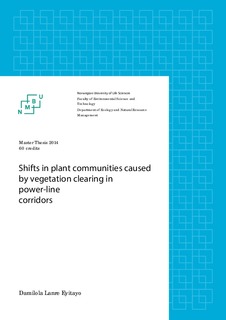| dc.description.abstract | Habitat modification has been identified as one of the major threats to biodiversity and has increased over recent years due to growing human population and demand for resources. One omnipresent form of habitat modification is the creation of transmission lines by electricity distribution companies. Due to safety concerns, the vegetation beneath electricity transmission lines is maintained at young succession stages by frequent cutting.
Data was collected from 51 study sites in the south east Norway. All the sites were situated in forests intersected by a power-line corridor, and represent a range of boreal forest types. I focused on plant responses that may be of particular interest for managers, such as differences in plant community composition between the corridor and forest, total plant species richness and diversity, richness and relative abundance of some functional groups or single keystone species. Likewise, I focused on environmental factors that may be influenced by managers and planners.
Greater diversity of species was found to exist in the power-line corridors compared to the interior of the forest. Specifically, I found an increase in richness and relative abundance of forbs, shrubs, light tolerant species and species preferring nutrient rich soils. Although some other species such as bilberry and mosses decreased in the corridors. More importantly, it suggests that the corridors are able to resist plant invasions and support a greater diversity of cultural landscape species.
The site index was found to be highly significant in influencing the species composition of the corridor habitats. Total species richness and relative abundance of forbs, shrubs, and cultural landscape species increased with the site index, while the stage of succession and landscape heterogeneity also proved to be significant in shaping the species composition of the power-line corridors.
Synthesis and applications. This study confirms that less severe forms of disturbance such as the creation of power-line corridors can cause species diversity to increase and as such provide an opportunity to conserve biodiversity in the face of increasing human land use changes.
Key-words: power-line corridors, disturbance, functional groups, species richness, relative abundance, environmental variables | nb_NO |

